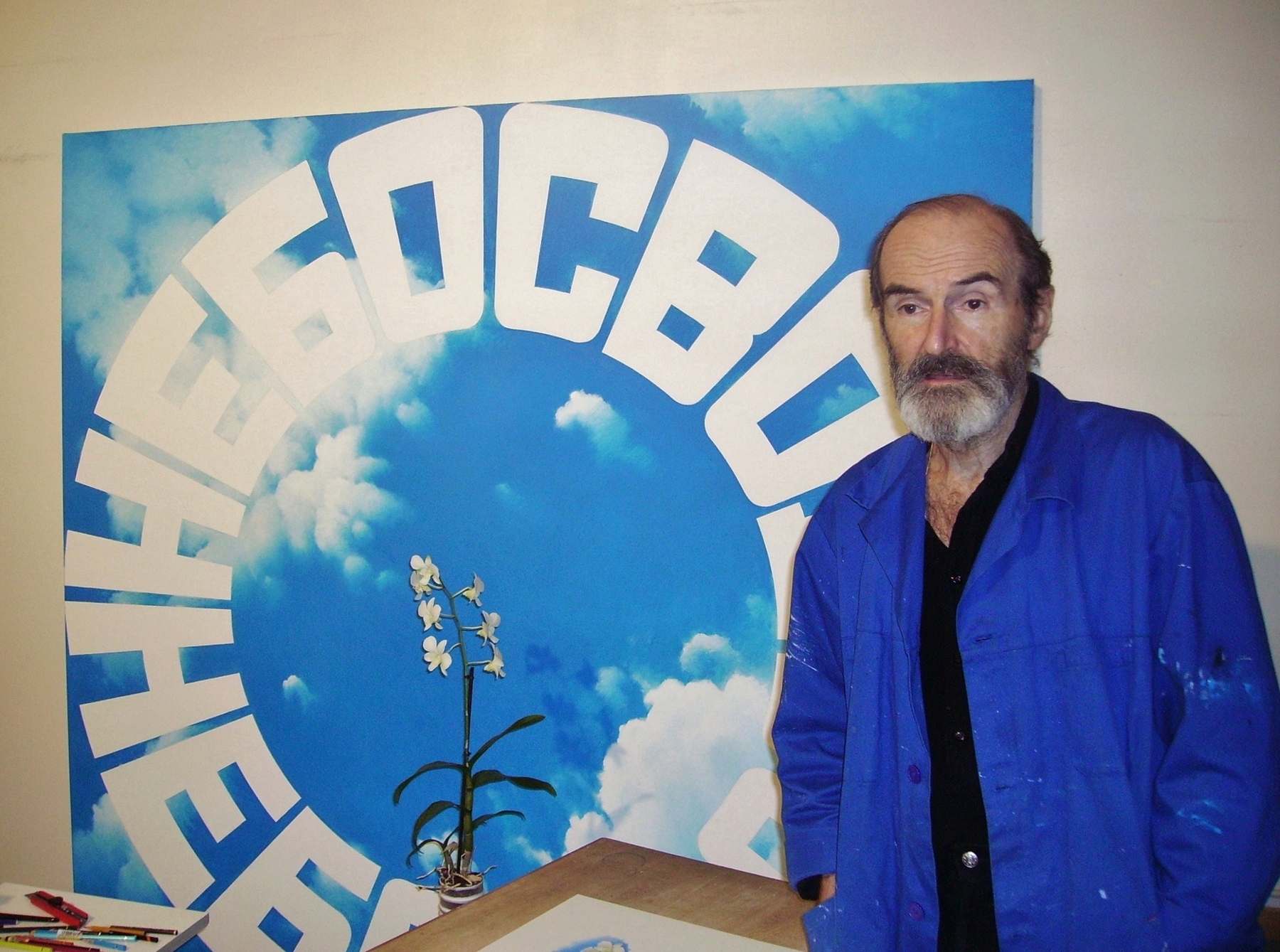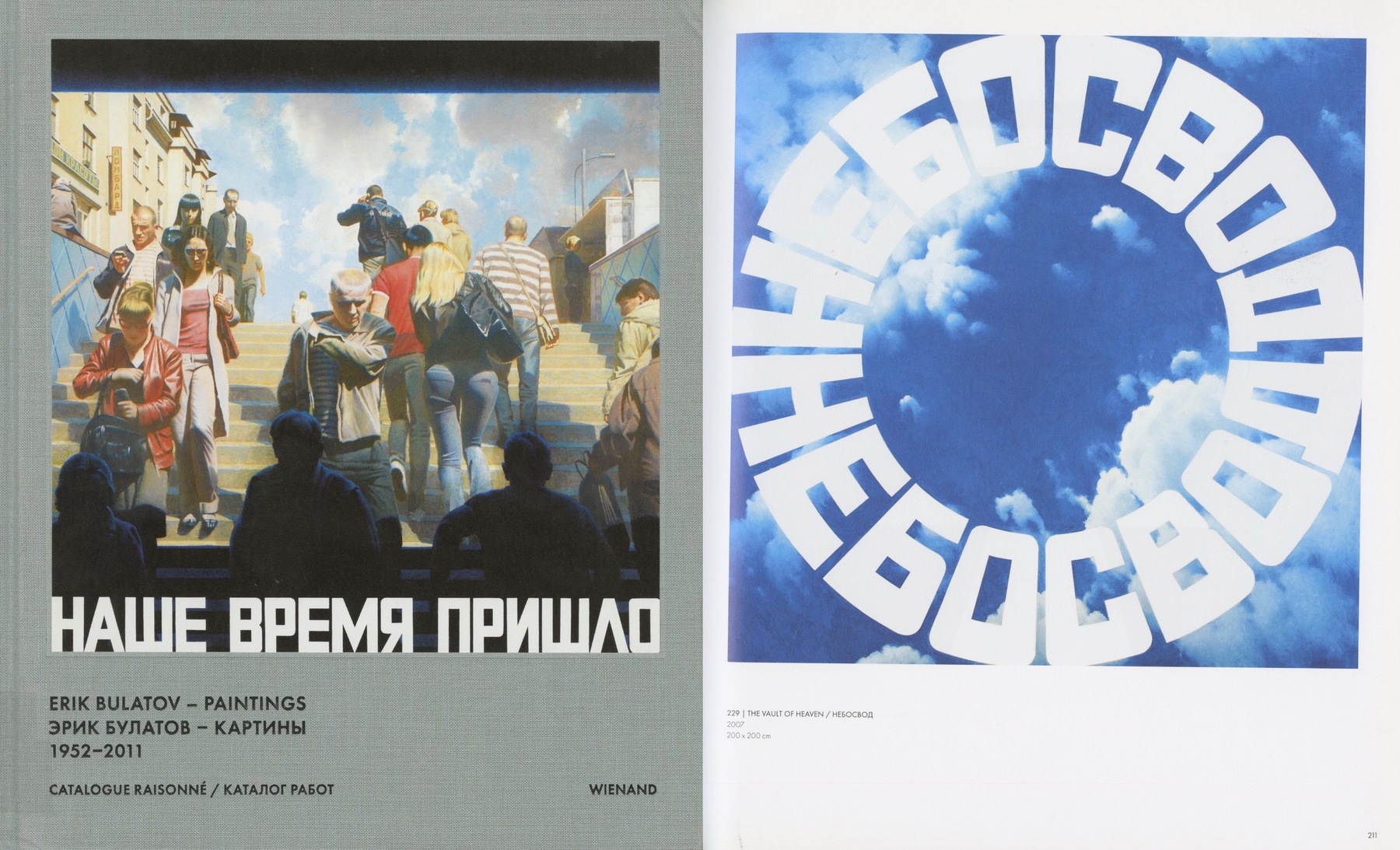Russian Art + NFT Auction
10 June 2021

*§ 154. BULATOV, ERIK (B. 1933)
The Vault of Heaven, signed, titled in Russian "Nebosvod" and in French "La voûte céleste", and dated 2007 on the reverse.
Oil on canvas, 200 by 200 cm.
400,000–600,000 GBP
Provenance: Collection of the artist, Paris.
Galerie Pièce Unique, Paris, 2008.
Private collection, Switzerland.
Certificate of authenticity from the artist.
Exhibition: Erik Bulatov, Galerie Pièce Unique, Paris, 17 January–5 April 2008.
Literature: A. Mathias, R. Kristin (eds.), Nashe Vremya Prishlo. Catalogue Raisonné of Erik Bulatov's Works 1952–2011, Cologne, Wienand Verlag, 2012, p. 211, illustrated.
Erik Bulatov’s masterpiece, The Vault of Heaven, presented here for auction belongs to a series of paintings inspired by the texts of Vsevolod Nekrasov (1934–2009), a minimalist poet of the Moscow Conceptual School and a close friend of the artist. In 2001 Erik Bulatov created his first work in this series, his famous Sky Horizon (Russian: Nebosvod Nebosklon). In his poems, Nekrasov reveals the opposition, concealed in the very construction of the compound Russian words meaning “sky/vault” and “sky/slope”, between the sky as a “dome” or “vault”, striving in the spring to reach its highest point, and the autumn sky moving to the “slope”, down to the horizon. In Sky Horizon Bulatov creates an ideal visual formula for this dichotomy, worthy of his best conceptual works. The arc of the hemispherical vault on the surface is the “sky” while its mirror image looking downwards from the horizon is the concave arc of the “horizon”. They are closed cycles and pass endlessly into each other, with the ascent being followed by a steady decline and then by a new ascent.
The artist himself explains the idea behind the painting as follows: “The impulse was provided by a poem written by Vsevolod Nekrasov. He is my favourite modern poet and means a lot to me. Space was turned inside out in it. And the result was sometimes the globe of the Earth and, at other times, quite the opposite, the depth; it was just such a double game.”
Returning to the same theme six years later in The Vault of Heaven of 2007 Bulatov resumes his deliberations on the most important theme in his works, the sky. In one of his interviews, he says: “In fact, I have worked a lot with the sky, ever since 1975, when I painted the picture I Am Going (Russian: Idu) – there was already movement in it through the picture, through the image. The sky for me is an image of freedom. I am convinced that there can be no freedom in the social space. I do not think that, all in all, for a person, the meaning of life, the meaning of existence, is to be found in the social space. The necessary needs are met there, but we do not live for that, we live for something else, it seems to me.”
The development of The Vault of Heaven or Sky theme over several years is the best confirmation that Bulatov’s interests are not restricted to Soviet society or to any society at all. He is interested in the problems of existence, which extend far beyond the social system and do not form part of the “Soviet/anti-Soviet” dialectic.
In compositions like The Vault of Heaven, the artist draws closer to philosophical, ontological issues and breaks out of the confines of social issues into the world of pure forms. In the 2001 version, Bulatov likens the sky to the globe and encloses it inside the circle of blue text letters that melt away at the edges, whereas in the 2007 version (with the canvas sizes being identical), the Vault of Heaven turns out to be boundless: the canvas captures only an insignificant fragment of it, and the white outlines of the words float beneath the clouds and turn into a multifaceted metaphor. The Russian word nebo (sky) is of Indo-European origin and one of the most ancient in the language. Its etymology comes close to the Greek νεφέλε (nephele) and the Latin nebula – “cloudiness” or “nebula”.
It is no coincidence that Bulatov’s skies are always covered with clouds, which turn them from a symbol of the absolute into a metaphor of eternal movement, changes of form, transience and the boundless, triumphant freedom of the universe.
It’s that life-long striving for the absolute that made Erik Bulatov one of the most celebrated and respected artists among contemporary conceptual painters. He created his own unique and instantly recognisable system, which embodies an unexpected clash between the poster-like sans-serif typeface text of Soviet totalitarian propaganda and a purely realistic component of contemporary world. The interaction of the pictorial space and the font itself in Bulatov’s works gives rise to a whole series of discoveries by an artist who works to comprehend some absolutely new super-reality and who convincingly proves that “the social space is limited, it has a boundary, and Freedom always lies on the other side of that boundary". The Vault of Heaven is a powerful work that enables us to draw closer to an understanding of the creative system of an outstanding artist of our times.
*
Simon Hewett interviewed Erik Bulatov in 2007, weeks before The Vault of Heaven went on show at Galerie Pièce Unique in Paris:
“Erik Bulatov was putting the finishing touches to The Vault of Heaven (Russian: Nebosvod) when I interviewed him in his cosy Paris flat close to Les Halles on 27 November 2007.
“Bulatov told me that his first painting to use lettering was Way In (Russian: Vkdod) in 1971. ‘I needed to use words to transform the white field from flat to spatial,’ he explained. He always uses capitals because ‘the lettering needs to look as simple as possible, like on posters.’
“Bulatov used the phrase Sky Horizon (Russian: Nebosvod Nebosklon) in his first painting to use circular lettering, in 2001. This work looks very similar to The Vault of Heaven of 2007, and is the same size and format. The Vault of Heaven, however, is repeated twice, with lettering in white; the lettering in the earlier work is blue.
‘The sky stands for freedom,’ he told me. ‘The sky embodies eternity. Blue is the colour of freedom and space. The letters and sky are far apart – not on the same plane. You can see that the letters are not written in the sky itself, but located a certain distance from it. The sky is on another plane – one that is free from the letters, where clouds are moving. The letters are still, but the sky is in motion: these are two different worlds. The sky is a space of freedom, where letters do not let us go.’
“The contrast between static lettering and dynamic Nature is explicit in Bulatov’s 2000 work How the Clouds Move (Russian: Kak idut oblaka). And the notion of sky embodying freedom is further explored in two other works from the same series Here (Russian: Vot), both entitled Freedom is Freedom (Russian: Svoboda est svoboda) – titles that punningly exploit the linguistic similarity between nebosvod and svoboda.
‘Such paintings,’ says Bulatov, ‘can only be understood through feelings and sensation. If you just read the letters you will not understand what I want to say. The main thing is emotional perception: to see the word in space’.
“Seven weeks after our interview, on 17 January 2008, The Vault of Heaven went on show at Pièce Unique. It was granted the melodious French title La Voûte Céleste and hung in splendid isolation on the back wall, summoning passers-by through the glass façade.
“Bulatov springs eternal.”
Erik Bulatov, Paris, 2007. Photo: Simon Hewitt
The present lot as illustrated in the 2012 catalogue raisonné
Verso of the present lot



Notes on symbols:
* Indicates 5% Import Duty Charge applies.
Ω Indicates 20% Import Duty Charge applies.
§ Indicates Artist's Resale Right applies.
† Indicates Standard VAT scheme applies, and the rate of 20% VAT will be charged on both hammer price and premium.